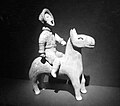File:Figurines used in lieu of human sacrifice. Terracotta warriors Exhibit. Asian Art Museum 2013.jpg
Page contents not supported in other languages.

Size of this preview: 679 × 599 pixels. Other resolutions: 272 × 240 pixels | 544 × 480 pixels | 870 × 768 pixels | 1,160 × 1,024 pixels | 2,320 × 2,048 pixels | 2,576 × 2,274 pixels.
Original file (2,576 × 2,274 pixels, file size: 3.6 MB, MIME type: image/jpeg)
| This is a file from the Wikimedia Commons. Information from its description page there is shown below. Commons is a freely licensed media file repository. You can help. |
Summary
| DescriptionFigurines used in lieu of human sacrifice. Terracotta warriors Exhibit. Asian Art Museum 2013.jpg |
English: A Chinese Warrior-State Qin terracotta figurine from a tomb in the Taerpo cemetery (塔兒坡秦墓) near Xianyang in Shaanxi Province, 4th-3rd century BCE. This is the earliest known representation of a cavalryman in China. Terracotta warriors Exhibit. Asian Art Museum 2013
|
| Date | |
| Source | https://www.flickr.com/photos/shockinglytasty/8690433795/ |
| Author | merri |
| Other versions |
 |
Licensing
This file is licensed under the Creative Commons Attribution-Share Alike 2.0 Generic license.
- You are free:
- to share – to copy, distribute and transmit the work
- to remix – to adapt the work
- Under the following conditions:
- attribution – You must give appropriate credit, provide a link to the license, and indicate if changes were made. You may do so in any reasonable manner, but not in any way that suggests the licensor endorses you or your use.
- share alike – If you remix, transform, or build upon the material, you must distribute your contributions under the same or compatible license as the original.
| This image was originally posted to Flickr by Shockingly Tasty at https://flickr.com/photos/49506223@N00/8690433795. It was reviewed on 19 October 2023 by FlickreviewR 2 and was confirmed to be licensed under the terms of the cc-by-sa-2.0. |
19 October 2023
Captions
Figurines used in lieu of human sacrifice. Terracotta warriors Exhibit. Asian Art Museum 2013
Items portrayed in this file
depicts
some value
image/jpeg
2,274 pixel
2,576 pixel
27 April 2013
ce0b938944284b60665695ccbd6d5cc8066c24ed
3,778,860 byte
File history
Click on a date/time to view the file as it appeared at that time.
| Date/Time | Thumbnail | Dimensions | User | Comment | |
|---|---|---|---|---|---|
| current | 19:11, 19 October 2023 |  | 2,576 × 2,274 (3.6 MB) | पाटलिपुत्र | Cleanup |
| 14:41, 19 October 2023 |  | 2,576 × 2,274 (3.61 MB) | पाटलिपुत्र | cropped, cleaned up | |
| 14:30, 19 October 2023 |  | 4,000 × 3,000 (1.23 MB) | पाटलिपुत्र | Uploaded a work by merri from https://www.flickr.com/photos/shockinglytasty/8690433795/ with UploadWizard |
File usage
The following pages on the English Wikipedia use this file (pages on other projects are not listed):
Metadata
This file contains additional information, probably added from the digital camera or scanner used to create or digitize it.
If the file has been modified from its original state, some details may not fully reflect the modified file.
| Width | 2,576 px |
|---|---|
| Height | 2,274 px |
| File change date and time | 16:40, 19 October 2023 |
| Software used | PaintShop Pro 20,00 |
